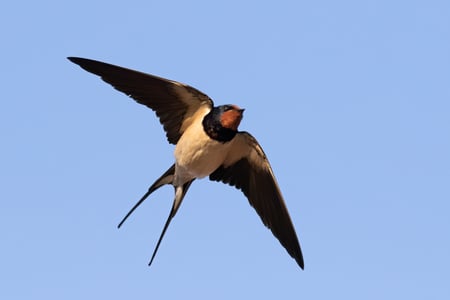Have you ever been enjoying an evening stroll through Nottingham Park, when suddenly you see a bright flash of turquoise? Or perhaps you’ve noticed what looks like a group of strange clay beehives stuck underneath the roof of a building? If so, you may have spotted one of our valley’s many species of swallows! Violet-green swallows (the flash of turquoise), cliff swallows (the clay beehives), as well as barn swallows all have expansive ranges throughout Colorado.

Perched Violet-Green Swallow
Violet-green swallows’ white bellies make them look like cotton balls dipped in fluorescent paint. Their coloration ranges from green and turquoise along their head and back, to blue and violet along their back and tail. Their scientific name, Tachycineta thalassina, means “fast moving” and “of the sea.” These sea-green colored birds are much faster than their small size suggests. They have been recorded flying up to 28 miles per hour. In comparison, the fastest diving bird, the peregrine falcon, only averages a 25-35 miles per hour flight speed! This speed comes in handy when it hunts for food by catching insects in the air.

Cliff swallows have a more patchy color pattern, which is perfect for camouflaging in their mud-colored cliffside nests. They have sleek, dark blue feathers in a big patch along their back and at the top of their head, surrounded by scattered patches of cinnamon colored feathers along their cheeks, neck and rump. They also have a light patch at the top of their head, just above their beak, as if they tried to put on sunscreen, but forgot to rub it in all the way. Despite their seemingly forgetful appearance, cliff swallows have a fantastic memory! They usually return to the same site each year to build their intricate nests that look like strange beehives, made with layers of puffy, little balls. Cliff swallows will scoop up a beakful of mud and carry it back to their nesting site, repeating this process many times to carefully build their homes. As they layer the mud, they use a special type of glue, their own saliva, which has chemical structures that help bond everything together. Cliff swallows usually prefer to nest in groups with up to 3,700 nests recorded in one site,

Cliff Swallow Nest
Barn swallows are deep, royal blue with a light brown belly. They look like a chunky little blueberry, dipped in caramel. They also have distinctively forked tails. The outer tail feathers are much longer than the rest, so they stick out when the birds are perched, making it look like they have two tiny swords stashed inside their tail. Barn swallows make nests similarly to cliff swallows, but in a more open, bowl shape. Barn swallows are the most abundant and widely distributed species of swallows in the world.
All three of these species are very important because they eat lots of flying insects, including flies, mosquitoes and wasps. These birds are threatened by habitat loss and food scarcity due to climate change, pollution and insecticides. Currently, swallows are headed south on their migration routes, chasing their insect prey all the way to Central and South America. Next time you see one, make sure to wish it safe travels!
 Flying Barn Swallow
Flying Barn Swallow
Carli Escamilla (she/her/hers) was recently a Naturalist at Walking Mountains Science Center. She spends her free time exploring trails, picking up litter and listening for birds








